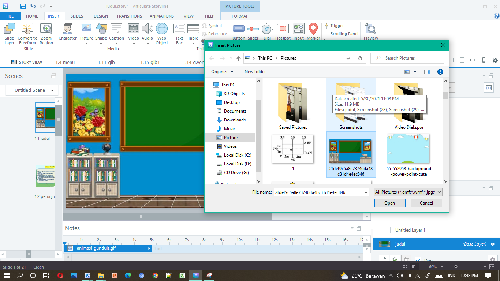Development of Physics E-Learning with Articulate Storyline Application to Improve Science Process Skills
Abstract
This research aims to develop physics e-learning with articulate storyline applications to improve science process skills. Researchis research and development. Development methods are 4D models with stages of define, design, development, and dissemination. The object of research is problem-based physics e-learning media with articulate storyline applications on straight-motion material. The test subjects were 20 students of grade X SMAN 1 Sikur. Data analysis techniques use qualitative and quantitative data analysis. The results of the study can be concluded that physics e-learning products with articulate storyline applications on straight-motion material are categorized as valid with an average score of 3.58, and physics e-learning is quite effective to be used to improve students' science process skills with a percentage of N-gain 58.13% with sufficient criteria effective
Full text article
References
Arends, R. (2013). Learn to Teach. Jakarta: Salemba Humanika
Bakri, F., &; Mulyati, D. (2017). Development of e-learning tools for Basic Physics II using LMS Chamilo. Journal of physics education vehicles. 2(1), 25-30. DOI: https://doi.org/10.17509/wapfi.v2i1.4868
Chandrawati, S. R. (2010). Utilization of E-learning in Learning. Journal of Educational Horizons, 8(2). 172-181. Retrieved from https://jurnal.untan.ac.id/index.php/jckrw/article/view/183
Chusna, N. L. (2019). E-learning Learning. In Proceedings of the National Seminar on Education KALUNI. 2(1). 113-117. http://dx.doi.org/10.30998/prokaluni.v2i0.36 DOI: https://doi.org/10.30998/prokaluni.v2i0.36
Conway-Klaassen, J. M., Wiesner, S. M., Desens, C., Trcka, P., &; Swinehart, C. (2012). Using online instruction and virtual laboratories to teach hemostasis in a medical laboratory science program. American Society for Clinical Laboratory Science, 25(4), 224-229. https://doi.org/10.29074/ascls.25.4.224 DOI: https://doi.org/10.29074/ascls.25.4.224
Dani, A. U., &; Arief, S. (2022). The influence of the use of multimedia articulate storyline on the physics learning outcomes of students. JPF (Journal of Physics Education) Alauddin State Islamic University Makassar, 10(2), 216-221. https://journal3.uin-alauddin.ac.id/index.php/PendidikanFisika/article/view/19363 DOI: https://doi.org/10.24252/jpf.v10i2.19363
Darnawati, D., Jamiludin, J., Batia, L., Irawaty, I., and Salim, S. (2019). Teacher empowerment through the development of interactive learning multimedia with articulate storyline applications. Scientific Charity: Journal of Community Service. 1(1), 8-16. https://ojs.uho.ac.id/index.php/amalilmiah/article/view/8780 DOI: https://doi.org/10.36709/amalilmiah.v1i1.8780
Gunawan., Setiawan. A, & Widyantoro D.H. (2013). Virtual Laboratory Model of Modern Physics to Improve Generic Science Skills of Teacher Candidates. Journal of Education and Learning. 20(1), 25-32. http://journal.um.ac.id/index.php/pendidikan-dan-pembelajaran/article/view/3867
Hadza, C., Sesrita, A., &; Suherman, I. (2020). Development of Learning Media Based on Articulate Storyline. Indonesian Journal of Applied Research (IJAR), 1(2), 80-85. https://iojs.unida.ac.id/index.php/IJAR/article/view/54 DOI: https://doi.org/10.30997/ijar.v1i2.54
Limbong, T., &; Simarmata, J. (2020). Media and Multimedia Learning: Theory & Practice. Our Foundation Writes.
Maharani, M., Supriadi, N., &; Widiyastuti, R. (2018). Cartoon-based mathematics learning media to reduce student anxiety. Decimal: Journal of Mathematics, 1(1), 101-106. http://ejournal.radenintan.ac.id/index.php/desimal/article/view/2036# DOI: https://doi.org/10.24042/djm.v1i1.2036
Muliyati, D., Marizka, H., &; Bakri, F. (2019). E-learning using wordpress on physics materials with the 5E learning cycle strategy. Journal of Physics Education Research & Development, 5(2), 101-112. http://journal.unj.ac.id/unj/index.php/jpppf/article/view/12342 DOI: https://doi.org/10.21009/1.05205
Novitasari, D., Wibowo, F. C., &; Raihanati, R. (2023, January). Articulate Storyline-assisted STEM-based Fluid Android (ADRODA) app. In Proceedings of the National Seminar on Physics (E-JOURNAL) 11(1). https://journal.unj.ac.id/unj/index.php/prosidingsnf/article/view/33683/14715
Nurmala, S., Triwoelandari, R., &; Fahri, M. (2021). Development of articulate storyline 3 media in STEM-based science learning to develop the creativity of elementary / MI students. Basicedu Journal, 5(6), 5024-5034. https://jbasic.org/index.php/basicedu/article/view/1546/pdf. DOI: https://doi.org/10.31004/basicedu.v5i6.1546
Primary, R. A. (2019). Learning media based on Articulate Storyline 2 on Drawing Function Graphs at SMP Patra Dharma 2 Balikpapan. Journal of Dimensions, 7(1), 19–35. https://Doi.Org/10.33373/Dms.V7i1.1631 DOI: https://doi.org/10.33373/dms.v7i1.1631
Solikha, Nikmatus., Suchainah., &; Rashida, Irfah. (2020). The Effectiveness of Schoology-Based E-learning Learning on Improving Student Effectiveness and Learning Outcomes. Journal of Ilmia, Education & Social. 11(1), 31-42.
Suartama, I. K. (2014). E-learning: Concepts and Applications. Ganesha University of Education. Singaraja.
Supardiyono. (2009). Implementation of Experimental Methods in Physics Learning in Junior High School. Faculty of Mathematics and Natural Sciences, Yogyakarta State University. Yogyakarta.
Yuliati, Y. (2016). Improvement of Science Process Skills of Elementary School Students through Problem-Based Learning Model. Journal of Cakrawala Pendas. 2(2), 71-83. https://unma.ac.id/jurnal/index.php/CP/article/view/335
Waller, V. & Wilson, J. 2001. A definition for e-learning. TheODL QC Newsletter, pp. 1-2.
Wijayanti, W., &; Prayitno, T. A. (2021, November). Development of interactive multimedia based on articulate storyline as a learning medium for grade X high school students. In Proceedings of IKIP Budi Utomo National Seminar. 2(1). 515-522. http://ejurnal.budiutomomalang.ac.id/index.php/prosiding/article/view/1475 DOI: https://doi.org/10.33503/prosiding.v2i01.1475
Authors
Copyright (c) 2023 Sutrio Sutrio, I Wayan Gunada, Baiq Sumaeni

This work is licensed under a Creative Commons Attribution 4.0 International License.

